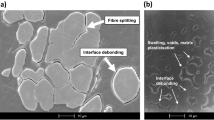Abstract
This paper presents the development of a higher-order direct boundary integral-displacement discontinuity method for crack propagation in layered elastic materials. The method is based on the dual boundary integral equations of linear elasticity which are solved by means of a quadratic boundary element formulation. The analytical solution for a point force within a bonded half-plane region is used to derive the kernel functions of the boundary integral equations. Square-root displacement-discontinuity elements are used to model the crack tips, and stress intensity factors may be computed using the numerically predicted values of the displacement discontinuity components at the midpoints of these crack-tip elements. An algorithm based on the maximum tensile-stress criterion is then developed and incorporated into the boundary element model to predict the paths of cracks propagating in layered elastic materials.
In the experimental part of this study, crack profiles for straight-through-cracked, compact-tension specimens of the anodically bonded silicon/Pyrex glass system are measured by profilometry. The plane strain prediction of the crack-propagation path is compared with the experimentally measured crack profiles. Consistent with the prediction, the interfacial crack is observed to kink away from the strong, anodically-bonded interface and propagate into the more compliant glass layer. The predicted initial kink angle of 26° agrees very well with the average measured value of 28°. The measured path of the crack is also in very good agreement with the predicted path over about the first 120 microns of crack growth with increasing deviation observed beyond that.
Similar content being viewed by others
References
M.J. Lii, Stress State near Bimaterial Interfaces. Ph.D. thesis, University of Minnesota (1989).
R. Jacobson, Simulation Methods for Stress Analysis in Bi-material Interface Problems. CIE Research, Center for Interfacial Engineering, University of Minnesota (1989).
A.R. Ingraffea, in Rock Fracture Mechanics, H.P. Rossmanith (ed.), Springer-Verlag, New York (1983) 151–208.
L.J. Gray, L.F. Martha and A.R. Ingraffea, International Journal of Numerical Methods in Engineering 29 (1990) 1135–1158.
S.L. Crouch and A.M. Starfield, Boundary Element Methods in Solid Mechanics, George Allen & Unwin, London (1983).
F.H. Cornet, Journal of Applied Mechanics 46 (1979) 349–355.
T.D. Wiles, Modeling of Hydraulic Propagation in a Discontinuous Rock Mass Using the Displacement Discontinuity Method. Ph.D. thesis, University of Toronto, Canada (1985).
J.A.L. Napier, Mechanics of Jointed and Faulted Rock, H.P. Rossmanith (ed.) (1990) 709–715.
J.L. Carvalho and J.H. Curran, Journal of Applied Mechanics 59:2:1 (1992) 321–327.
S. Selcuk, A Higher-Order Direct Boundary Integral-Displacement Discontinuity Method for Fracture Propagation in Layered Elastic Media. Ph.D. thesis, University of Minnesota (1992).
S.L. Crouch and S. Selcuk, International Journal of Rock Mechanics and Mining Sciences & Geomechanics Abstracts 29:5 (1992) 491–501.
S. Selcuk and S.L. Crouch, Proceedings of 33rd U.S. Symposium on Rock Mechanics (1992) 629–638.
A.M. Crawford and J.H. Curran, International Journal of Rock Mechanics and Mining Sciences & Geomechanics Abstracts 19 (1982) 143–148.
J.R. Rice and G.C. Sih, Journal of Applied Mechanics 32 (1965) 418–423.
J.W. Hutchinson, M.E. Mear and J.R. Rice, Journal of Applied Mechanics 54 (1987) 828–832.
W. Zang and P. Gudmundson, International Journal of Fracture 54 (1992) 65–77.
F. Erdogan and G.C. Sih, Journal of Basic Engineering (1963) 519–525.
G.C. Sih, Engineering Fracture Mechanics 5 (1973) 365–377.
K. Palaniswamy and W.G. Knauss, On the Problem of Crack Extension in Brittle Solids under General Loading. Report SM-74-8, Graduate Aeronautical Laboratory, California Institute of Technology (1972).
M.A. Hussain, S.L. Pu and J. Underwood, Fracture Analysis, ASTM-STP 560 (1974) 2.
M.Y. He and J.W. Hutchinson, Journal of Applied Mechanics 56 (1989) 270–278.
J.W. Hutchinson and Z. Suo, Advances in Applied Mechanics 29 (1992) 63–191.
L. Vandamme, A Three-Dimensional Displacement Discontinuity Model for the Analysis of Hydraulically Propagated Fractures. Ph.D. thesis, University of Toronto, Canada (1986).
H. Bergvist and L. Guex, International Journal of Fracture 15:5 (1979) 429–441.
F.P. Chiang and X.T. Yan, Proceedings of SEM Spring Conference on Experimental Mechanics (1989) 415–422.
H. Guo, N.I. Aziz and L.C. Schmidt, Engineering Fracture Mechanics 36 (1990) 933–943.
D. Swenson and C. Rau, International Journal of Fracture Mechanics 6:4 (1970) 357–365.
T.J. Lardner, J.E. Ritter, M.L. Shiao and M.R. Lii, International Journal of Fracture 44 (1990) 133–143.
G. Wallis and D.I. Pomerantz, Journal of Applied Physics 40 (1969) 3946–3949.
K.B. Albaugh, Mechanisms of Anodic Bonding. Ph.D. thesis, Clarkson University (1986).
Author information
Authors and Affiliations
Rights and permissions
About this article
Cite this article
Selcuk, S., Hurd, D.S., Crouch, S.L. et al. Prediction of interfacial crack path: a direct boundary integral approach and experimental study. Int J Fract 67, 1–20 (1994). https://doi.org/10.1007/BF00032361
Received:
Accepted:
Issue Date:
DOI: https://doi.org/10.1007/BF00032361




